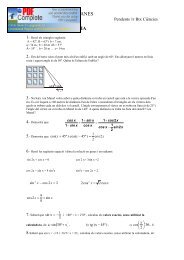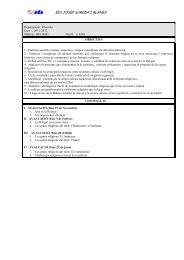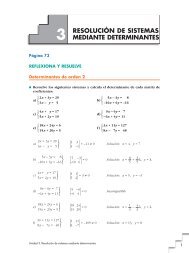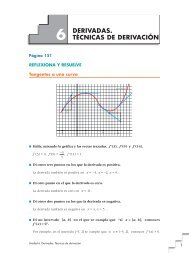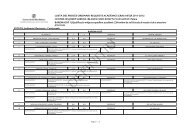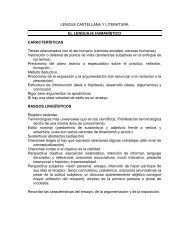APLICACIONES DE LAS DERIVADAS
APLICACIONES DE LAS DERIVADAS
APLICACIONES DE LAS DERIVADAS
You also want an ePaper? Increase the reach of your titles
YUMPU automatically turns print PDFs into web optimized ePapers that Google loves.
UNIDAD<br />
7<br />
2. Halla las ecuaciones de las rectas tangentes a la curva:<br />
y = x 3 – 4x + 3<br />
que sean paralelas a la bisectriz de los cuadrantes segundo y cuarto.<br />
y = x 3 – 4x + 3<br />
Calculamos la derivada:<br />
y' = 3x 2 – 4<br />
Si son paralelas a la bisectriz del 2.° y 4.° cuadrante, la pendiente es –1. Por tanto:<br />
3x 2 – 4 = 1 8 3x 2 = 3 8 x 2 = 1 8 x = ±1<br />
y (–1) = 6<br />
y (1) = 0<br />
Recta tangente en (–1, 6):<br />
y = 6 – (x + 1) = –x + 5<br />
Recta tangente en (1, 0):<br />
y = 0 – (x – 1) = –x +1<br />
Página 169<br />
1. Dada la función y = x 3 – 3x 2 – 9x + 5, averigua:<br />
a) Dónde crece.<br />
b) Dónde decrece.<br />
y' = 3x 2 – 6x – 9 = 3(x 2 – 2x – 3) = 3(x – 3)(x + 1)<br />
a) x < –1 8 y' > 0 8 f es creciente en (–@, –1)<br />
x > 3 8 y' > 0 8 f es creciente en (3, +@)<br />
b) –1 < x < 3 8 y' < 0 8 f es decreciente en (–1, 3)<br />
Página 171<br />
2. Comprueba que la función y = x 3 /(x – 2) 2 tiene solo dos puntos singulares,<br />
en x = 0 y en x = 6.<br />
Averigua de qué tipo es cada uno de esos dos puntos singulares; para ello, debes<br />
estudiar el signo de la derivada.<br />
y' =<br />
3x 2 (x – 2) 2 – 2(x – 2)x 3<br />
=<br />
x 2 (x – 2) (3(x – 2) – 2x) =<br />
(x – 2) 4<br />
(x – 2) 4<br />
=<br />
x 2 (3x – 6 – 2x)<br />
= x2 (x – 6)<br />
(x – 2) 3 (x – 2) 3<br />
Unidad 7. Aplicaciones de las derivadas<br />
3



